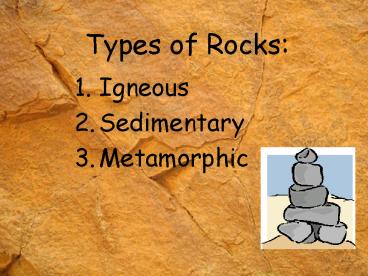Types of Rocks: PowerPoint PPT Presentation
1 / 24
Title: Types of Rocks:
1
Types of Rocks
- Igneous
- Sedimentary
- Metamorphic
2
Igneous Rocks
- Rocks that forms when magma cools and hardens.
- Form by solidification (crystallization) of
melted minerals.
- At the surface, LAVA hardens to form EXTRUSIVE
- rocks with tiny (FINE-GRAINED) crystals or GLASSY
- (no crystal) textures.
- Beneath the surface, MAGMA hardens to form
- INTRUSIVE rocks with easily visible
(COARSE-GRAINED) crystal texture.
3
2 groups of Igneous Rock
- Intrusive igneous rock The slow cooling of
magma deep below the crust. - Slow loss of heat ? Long time ? large, well
developed crystal grains. - Extrusive igneous rock The rapid cooling of
lava on the earths surface. - Fast loss of heat ? Short time ? Cant form
large crystals
4
Granite
Rhyolite
5
Mineral Composition
- Felsic igneous rocks rich in light-colored
minerals such as orthoclase and quartz
- Mafic igneous rocks rich in dark-colored
- ferromagnesian minerals
6
Igneous Examples
- Dark-colored, fine- grained, extrusive
- Formed where lava erupted onto surface
- Most widespread igneous rock
7
Igneous Examples
- Natural volcanic glass
- Forms when lava cools very quickly
- Usually dark, but small pieces may be clear
- Fractures along curved (conchoidal) surface
Obsidian
- Light colored, frothy
- (many air spaces)
Pumice
8
Sedimentary Rocks
- Formed from the compaction and cementation of
loose, solid particles (aka sediment).
- Types of Formation
- Lithification of sediment
- Precipitation from solution
- Consolidation of organic remains
9
Types of Formation
CEMENTATION
COMPACTION
Lithification
10
Types of Formation
Precipitation
11
Sedimentary Rock Groups
- CLASTIC
- Comprised of
- cemented sediment
- CHEMICAL
- Precipitation of
- minerals from
- solution
- ORGANIC
- From the remains
- of organisms
12
Sedimentary Examples
Conglomerate
Breccia
Rounded
Angular
13
Sedimentary Examples
- Coquina
- Type of limestone made up of fossil shells with
little or no matrix
Fossiliferous Limestone Contains the remains of
ancient plants animals, known as fossils
14
Metamorphic Rocks
- Formed when existing rocks undergo great amounts
of heat pressure. - Minerals recrystallize to form new minerals
- Minerals change in size shape
- Minerals may line up in parallel bands
- All of this creates a new rock!
15
Controlling Factors of Metamorphism
- Parent Rock composition
- Temperature certain minerals are unstable under
specific temperatures - Time the longer it takes for metamorphism to
occur, the more change that occurs - Pressure increases as depth into the Earths
crust increases
16
Types of Metamorphism
- Contact Metamorphism
- magma comes into contact with existing rock
- heat from the magma can change the structure
mineral makeup of that rock.
17
Types of Metamorphism
- Regional Metamorphism
- occurs over a large area
- changes that take place at great depth (more than
5km) below ground - related to plate tectonics
- causes a change in texture, structure, or
composition of a rock.
18
Regional Metamorphism
19
Metamorphic Rock Groups
- Foliated minerals within the rock arranged in
bands or planes - Banding- alternating bands of light and
dark minerals - Schistocity- minerals have grown parallel
planes in rock - Rock Cleavage- looks like a rock can
break into plates
20
Foliation
Realigned minerals in bands
Minerals in random order
HEAT
HEAT
21
Foliated Metamorphic Rocks
Banding
Schistocity
Rock Cleavage
22
(No Transcript)
23
(No Transcript)
24
Identifying Rocks
- Observe and ask questions
- What does the rock look like?
- Examine the grain of a section.
- What is the rock's composition?
- Determine what minerals are in it.
- Where was the rock found?
- Mountain
- Stream or river
- Volcano
- Ocean floor

